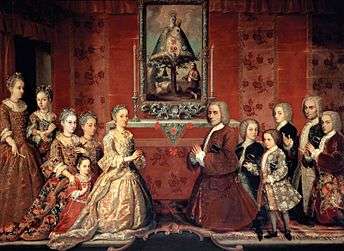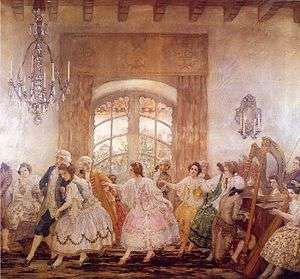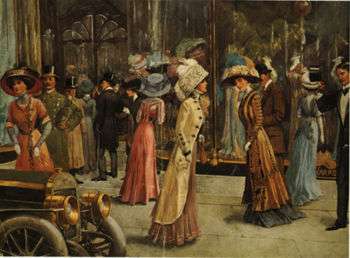Upper class
The upper class in modern societies is the social class composed of people who hold the highest social status, usually are the wealthiest members of class society, and wield the greatest political power.[1] According to this view, the upper class is generally distinguished by immense wealth which is passed on from generation to generation.[2] Prior to the 20th century, the emphasis was on aristocracy, which emphasized generations of inherited noble status, not just recent wealth.[3]
Because the upper classes of a society may no longer rule the society in which they are living, they are often referred to as the old upper classes and they are often culturally distinct from the newly rich middle classes that tend to dominate public life in modern social democracies. According to the latter view held by the traditional upper classes, no amount of individual wealth or fame would make a person from an undistinguished background into a member of the upper class as one must be born into a family of that class and raised in a particular manner so as to understand and share upper class values, traditions, and cultural norms. The term is often used in conjunction with terms like upper-middle class, middle class, and working class as part of a model of social stratification.
Historical meaning

Historically in some cultures, members of an upper class often did not have to work for a living, as they were supported by earned or inherited investments (often real estate), although members of the upper class may have had less actual money than merchants.[4] Upper-class status commonly derived from the social position of one's family and not from one's own achievements or wealth. Much of the population that composed the upper class consisted of aristocrats, ruling families, titled people, and religious hierarchs. These people were usually born into their status and historically there was not much movement across class boundaries.

In many countries, the term "upper class" was intimately associated with hereditary land ownership. Political power was often in the hands of the landowners in many pre-industrial societies despite there being no legal barriers to land ownership for other social classes. Upper-class landowners in Europe were often also members of the titled nobility, though not necessarily: the prevalence of titles of nobility varied widely from country to country. Some upper classes were almost entirely untitled, for example, the Szlachta of the Polish–Lithuanian Commonwealth.
British Isles and colonies

In the United Kingdom and Republic of Ireland (before and after its succession from the United Kingdom in 1922), the "upper class" traditionally comprised the landed gentry and the aristocracy of noble families with hereditary titles. The vast majority of post-medieval aristocratic families originated in the merchant class and were ennobled between the 14th and 19th centuries while intermarrying with the old nobility and gentry.[5] Since the Second World War, the term has come to encompass rich and powerful members of the managerial and professional classes as well.[6]
United States
.jpg)
In the United States, the upper class, as distinguished from the rich, is often considered to consist of those families that have for many generations enjoyed top social status based on their leadership in society. In this respect, the US differs little from countries such as the UK where membership of the 'upper class' is also dependent on other factors. In the United Kingdom, it has been said that class is relative to where you have come from, similar to the United States where class is more defined by who as opposed to how much; that is, in the UK and the US people are born into the upper class. The American upper class is estimated to constitute less than 1% of the population. By self-identification, according to this 2001–2012 Gallup Poll data, 98% of Americans identify with the 5 other class terms used, 48–50% identifying as "middle class".[7]
The main distinguishing feature of the upper class is its ability to derive enormous incomes from wealth through techniques such as money management and investing, rather than engaging in wage-labor or salaried employment.[8][9][10] Successful entrepreneurs, CEOs, politicians, investment bankers, venture capitalists, heirs to fortunes, some lawyers, top-flight physicians, and celebrities are considered members of this class by contemporary sociologists, such as James Henslin or Dennis Gilbert.[8] There may be prestige differences between different upper-class households. An A-list actor, for example, might not be accorded as much prestige as a former U.S. President,[9] yet all members of this class are so influential and wealthy as to be considered members of the upper class.[8] At the pinnacle of U.S wealth, 2004 saw a dramatic increase in the numbers of billionaires. According to Forbes Magazine, there are now 374 U.S. billionaires. The growth in billionaires took a dramatic leap since the early 1980s, when the average net worth of the individuals on the Forbes 400 list was $400 million. Today, the average net worth is $2.8 billion. Wal-Mart Walton family now has 771,287 times more than the median U.S household (Collins and Yeskel 322).[11]
Upper-class families... dominate corporate America and have a disproportionate influence over the nation's political, educational, religious, and other institutions. Of all social classes, members of the upper class also have a strong sense of solidarity and 'consciousness of kind' that stretches across the nation and even the globe.
— William Thompson & Joseph Hickey, Society in Focus, 2005[9]
Since the 1970s income inequality in the United States has been increasing, with the top 1% experiencing significantly larger gains in income than the rest of society.[12][13][14] Alan Greenspan, former chair of the Federal Reserve, sees it as a problem for society, calling it a "very disturbing trend".[15][16]
According to the book Who Rules America? by William Domhoff, the distribution of wealth in America is the primary highlight of the influence of the upper class. The top 1% of Americans own around 34% of the wealth in the U.S. while the bottom 80% own only approximately 16% of the wealth. This large disparity displays the unequal distribution of wealth in America in absolute terms.[17]
In 1998, Bob Herbert of The New York Times referred to modern American plutocrats as "The Donor Class"[18][19] (list of top donors)[20] and defined the class, for the first time,[21] as "a tiny group – just one-quarter of 1 percent of the population – and it is not representative of the rest of the nation. But its money buys plenty of access".[18]
See also
- Aristocracy (class)
- Bildungsbürgertum
- Corporate class
- Debutante
- Donor Class
- Fat cat (term)
- Gentry
- Grand Burgher (German Großbürger)
- High society (social class)
- Honour
- International Debutante Ball
- La Distinction
- Landed gentry
- Mentifact
- Nobility
- Nouveau riche
- Old money
- Patrician (post-Roman Europe)
- Social status
- Socialite
References
- Bartels, Larry (8 April 2014). "Rich people rule!". Archived from the original on 17 April 2016. Retrieved 17 July 2016 – via www.washingtonpost.com.
- Akhbar-Williams, Tahira (2010). "Class Structure". In Smith, Jessie C. (ed.). Encyclopedia of African American Popular Culture, Volume 1. ABC-CLIO. p. 322. ISBN 978-0-313-35796-1. Archived from the original on 21 November 2015. Retrieved 29 October 2015.
- Gregory Mantsios (2010). "Class in America – 2009". In Rothenberg, Paula S. (ed.). Race, class, and gender in the United States: an integrated study (8th ed.). New York: Worth Publishers. p. 179. ISBN 978-1-4292-1788-0.
- "How should we define working class, middle class and upper class?". The Guardian. Guardian News and Media Limited. 2011. Archived from the original on 15 September 2018. Retrieved 15 September 2018.
- Toynbee, Arnold (1960). Study of History: Abridgement of Vols I-X in one volume. Oxford University Press.
- Krummel, Victoria (2008). The Old Upper Class – Britain's Aristocracy. Akademische Schriftenreihe. GRIN Verlag. p. 5. ISBN 978-3-638-74726-4.
- Dugan, Andrew (30 November 2012). "Americans Most Likely to Say They Belong to the Middle Class". Gallup. Archived from the original on 11 March 2016. Retrieved 10 March 2016.
- Gilbert, Dennis (1998). The American Class Structure. New York: Wadsworth Publishing. ISBN 0-534-50520-1.
- Thompson, William; Hickey, Joseph (2005). Society in Focus. Boston, Mass.: Pearson. ISBN 0-205-41365-X.
- Williams, Brian; Sawyer, Stacey C.; Wahlstrom, Carl M. (2005). Marriages, Families & Intimate Relationships. Boston, Mass.: Pearson. ISBN 0-205-36674-0.
- "State Personal Income 2013" (PDF). U.S. Bureau of Economic Analysis. 25 March 2014. Archived from the original (PDF) on 13 April 2014. Retrieved 15 May 2014.
- Johnston, David Cay (29 March 2007). "Income Gap is Widening, Data Shows". The New York Times. Archived from the original on 5 November 2007. Retrieved 20 June 2007.
- Thomas, E.; Gross, D. (23 July 2007). "Taxing the Rich". Newsweek.
- Johnston, David Cay (5 June 2005). "Richest Are Leaving Even the Rich Far Behind". The New York Times. ISSN 0362-4331. Archived from the original on 9 October 2016. Retrieved 26 June 2015.
- Pizzigati, S. (7 November 2005). "Alan Greenspan, Egalitarian?". TomPaine.com. Archived from the original on 30 September 2007. Retrieved 20 June 2007.
- Greenspan, Alan (28 August 1998). "Remarks by Chairman Alan Greenspan". The Federal Reserve Board. Archived from the original on 6 June 2007. Retrieved 20 June 2007.
- Domhoff, G. William (2005). Who Rules America: Power, Politics, & Social Change (5th ed.). New York: McGraw-Hill. ISBN 0-07-287625-5.
- Herbert, Bob (19 July 1998). "The Donor Class". The New York Times. Archived from the original on 11 March 2016. Retrieved 10 March 2016.
- Confessore, Nicholas; Cohen, Sarah; Yourish, Karen (10 October 2015). "The Families Funding the 2016 Presidential Election". The New York Times. Archived from the original on 10 March 2016. Retrieved 10 March 2016.
- Lichtblau, Eric; Confessore, Nicholas (10 October 2015). "From Fracking to Finance, a Torrent of Campaign Cash - Top Donors List". The New York Times. Archived from the original on 10 March 2016. Retrieved 11 March 2016.
- McCutcheon, Chuck (26 December 2014). "Why the 'donor class' matters, especially in the GOP presidential scrum". "The Christian Science Monitor. Archived from the original on 11 March 2016. Retrieved 10 March 2016.
Further reading
- Allan G. Johnson, ed. (2000). "Upper class". The Blackwell Dictionary of Sociology: A User's Guide to Sociological Language (2nd ed.). Wiley-Blackwell. ISBN 978-0-631-21681-0.
- Hartmann, Michael (2007). The Sociology of Elites. Routledge Studies in Social and Political Thought. 50. Taylor & Francis. ISBN 978-0-415-41197-4.
- King, Victor T. (2008). The Sociology of Southeast Asia: Transformations in a Developing Region. NIAS Press. ISBN 978-87-91114-60-1.
- McKibbin, Ross.(2000) Classes and Cultures: England 1918-1951 (2000) pp 1–43.
- Baraka, Magda. (1998). The Egyptian upper class between revolutions, 1919-1952. ISBS.
- Scott, John. (1982). The upper classes: Property and privilege in Britain Macmillan Pub Ltd.
United States
- Baltzell, E. Digby. Philadelphia Gentlemen: The Making of a New Upper Class (1958).
- Brooks, David. Bobos in paradise: The new upper class and how they got there (2010)
- Burt, Nathaniel. The Perennial Philadelphians: The Anatomy of an American Aristocracy (1999).
- Davis, Donald F. "The Price of Conspicious Production: The Detroit Elite and the Automobile Industry, 1900-1933." Journal of Social History 16.1 (1982): 21–46. online
- Farnum, Richard. "Prestige in the Ivy League: Democratization and discrimination at Penn and Columbia, 1890-1970." in Paul W. Kingston and Lionel S. Lewis, eds. The high-status track: Studies of elite schools and stratification (1990).
- Ghent, Jocelyn Maynard, and Frederic Cople Jaher. "The Chicago Business Elite: 1830–1930. A Collective Biography." Business History Review 50.3 (1976): 288–328. online
- Hood. Clifton. In Pursuit of Privilege: A History of New York City's Upper Class and the Making of a Metropolis (2016). Covers 1760–1970.
- Jaher, Frederic Cople, ed. The Rich, the Well Born, and the Powerful: Elites and Upper Classes in History (1973), essays by scholars
- Jaher, Frederick Cople. The Urban Establishment: Upper Strata in Boston, New York, Chicago, Charleston, and Los Angeles (1982).
- Jensen, Richard. "Family, Career, and Reform: Women Leaders of the Progressive Era." in Michael Gordon, ed., The American Family in Social-Historical Perspective,(1973): 267–80.
- McConachie, Bruce A. "New York operagoing, 1825-50: creating an elite social ritual." American Music (1988): 181–192. online
- Ostrander, Susan A. (1986). Women of the Upper Class. Temple University Press. ISBN 978-0-87722-475-4.
- Story, Ronald. (1980) The forging of an aristocracy: Harvard & the Boston upper class, 1800-1870
- Synnott, Marcia. The half-opened door: Discrimination and admissions at Harvard, Yale, and Princeton, 1900-1970 (2010).
- Williams, Peter W. Religion, Art, and Money: Episcopalians and American Culture from the Civil War to the Great Depression (2016), especially in New York City
External links
| Wikimedia Commons has media related to Upper-class. |
- Number of households with net-worths over one million dollars
- Relationship between income and education
- "The Aristocracy – how the ruling class survives" on BBC Radio 4's In Our Time featuring David Cannadine, Rosemary Sweet and Felipe Fernandez-Armesto